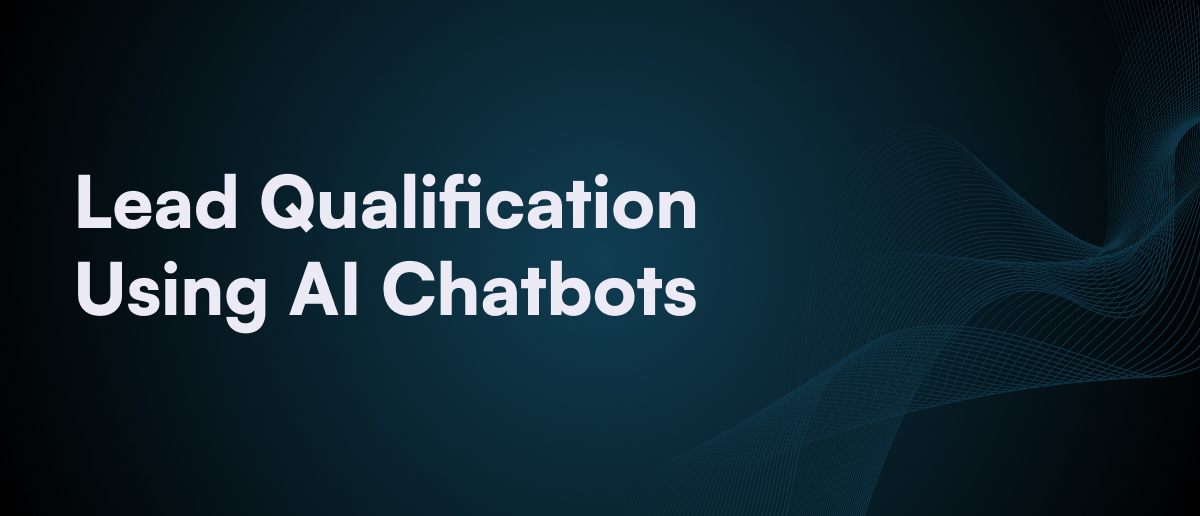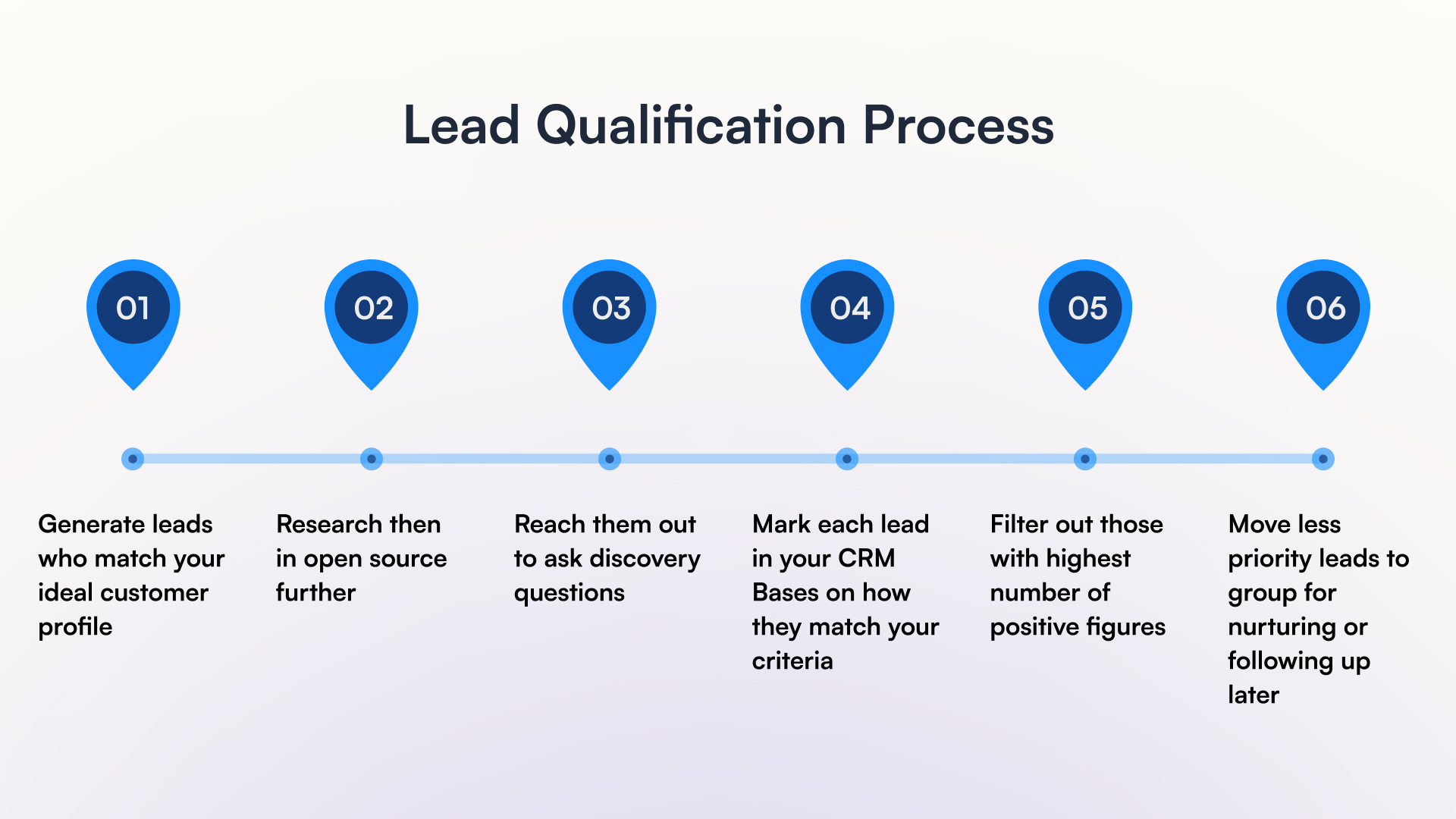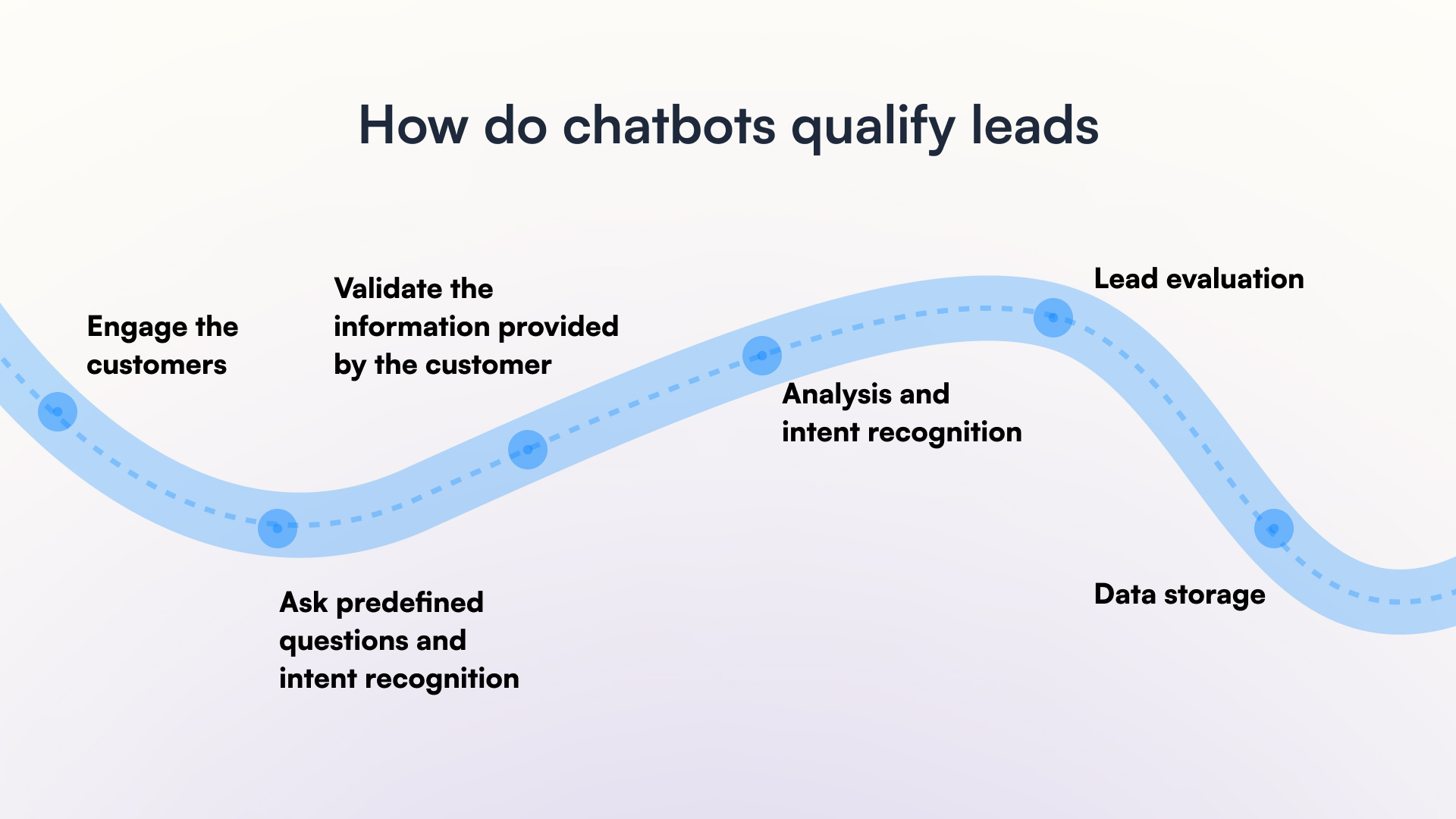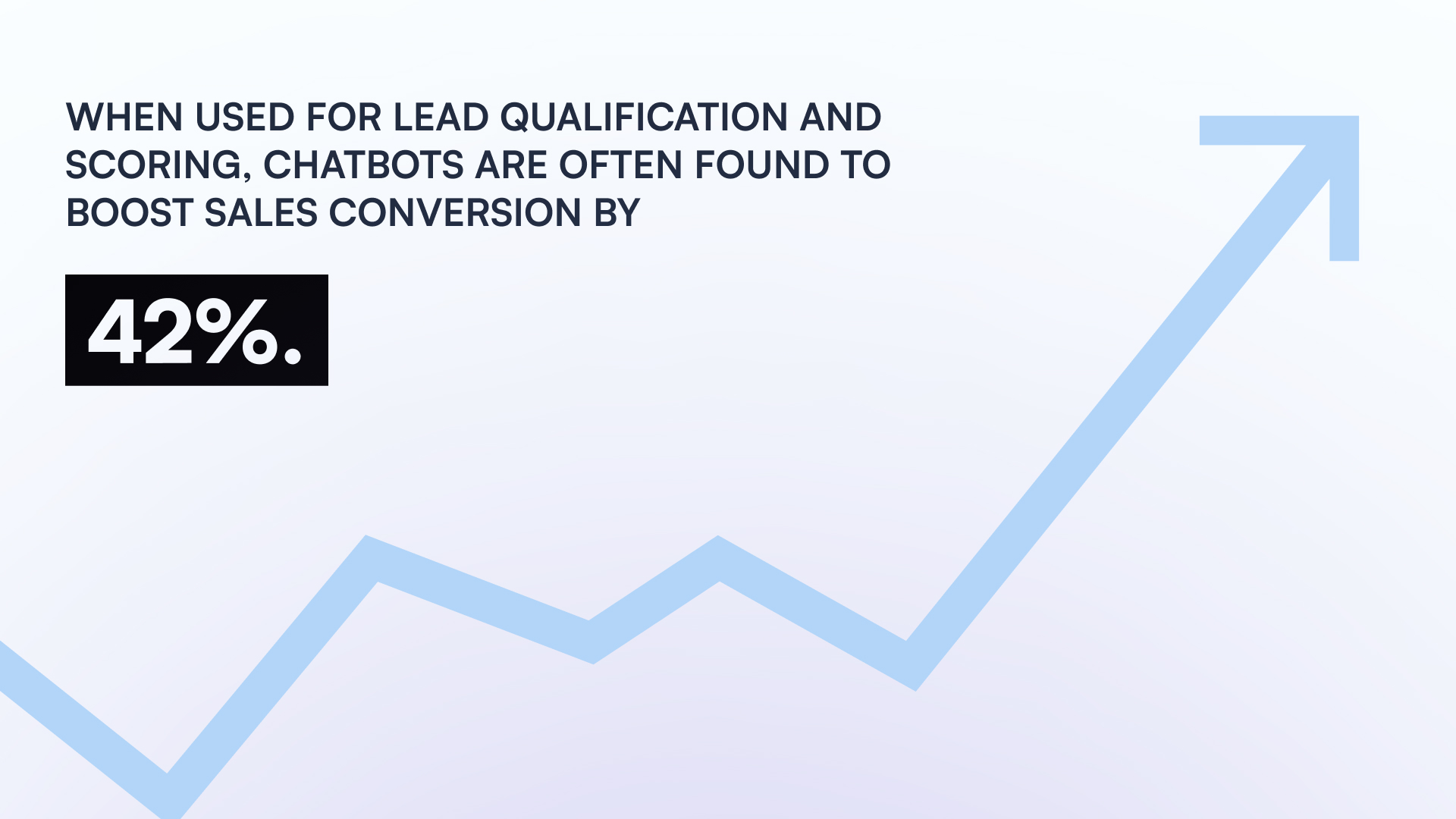How Do Chatbots Qualify Leads?


Sushree Sangeeta Behera
August 26, 2024
8 min
Table of Contents
Build Your No-Code Custom AI Agent
Get Started FreeImagine having a tireless assistant who works around the clock, sorting through potential customers, identifying the most promising ones, and delivering them right to your sales team’s doorstep.
Sounds too good to be true?
In a world where time is money and every lead counts, businesses are turning to AI-driven chatbots to streamline the qualification process.
But how exactly do they do it? And more importantly, how can you harness their potential for your business?
Let’s jump into the details of chatbot lead qualification and discover the magic behind their algorithms and machine learning capabilities.
What is Lead Qualification?

Lead qualification is the process of discovering potential leads (customers) who are genuinely interested, capable, and willing to purchase your product. For example, if you are selling apples, some visitors may want oranges, while others really want apples but are skeptical about whether they can afford them or have concerns about the quality.
By asking the right questions, you can determine their intentions and identify those who are truly interested. This method saves time and effort by focusing on those who are more likely to buy.
Similarly, in every business, lead qualification helps us identify potential customers, ensuring that we don’t waste time and resources on unlikely prospects.
However, when done manually, this process can be time-consuming, and the quality can suffer due to human error—something no company can afford when trying to scale. This is where a lead qualification chatbot comes into play. But before diving into that, let’s first understand what a lead qualification bot is.
What is a Lead Qualification Chatbot?
A lead qualification chatbot is an automated AI tool designed to qualify captured leads. It uses predetermined criteria and questions to converse with leads, collect required data, and score them to determine whether they should be qualified or disqualified.
The chatbot can then direct qualified leads to the right sales representative, who can focus on leads with a higher conversion rate, saving time and effort.
Moreover, a chatbot is an efficient option that speeds up the lead qualification process by capturing high-quality leads. Using a chatbot for lead qualification allows businesses to screen a larger volume of leads simultaneously, enabling the human sales team to be used more efficiently.
How do Chatbots Qualify Leads?

Chatbots qualify leads by asking strategic questions, gathering key information, and streamlining the vetting process for sales teams. Let’s explore the steps for how chatbots qualify leads.
1. Engagement
The process begins with the initial interaction between the customer and the chatbot. During this phase, the chatbot engages with customers by responding to their queries as they visit the website. This first interaction is crucial, as it sets the tone for the entire customer experience. The effectiveness of this exchange is driven by the chatbot’s Natural Language Processing (NLP) and machine learning capabilities, which enable it to understand and respond accurately.
2. Ask predefined questions and intent recognition
Chatbot is programmed with predesigned questions to extract important information from the customer. These questions are designed to focus on four key elements: budget, authority, need, and timeline.
3. Validation
The chatbot validates the information provided by the customer to ensure accuracy. For instance, if a lead mentions having a high budget but also identifies as a small startup, the chatbot may seek clarification to resolve this discrepancy. Based on the responses, the chatbot can detect inconsistencies and tag them for human assistance when necessary.
4. Analysis and intent recognition
Using advanced NLP techniques, the chatbot analyzes customer responses to understand their intent and context, and assess how well the lead aligns with the business’s offerings. This approach also effectively gauges the lead’s level of urgency and interest, helping to prioritize follow-up actions.
5. Lead evaluation
The chatbot evaluates the customer’s responses and assigns a lead score based on its analysis. Depending on the score, the leads are then categorized into different segments according to their readiness to make a purchase. This categorization allows for prioritizing follow-up actions effectively.
6. Data storage
The chatbot will store all the data and reports from the analysis and segmentation. Human agents can then use this information to reach out to qualified leads.
Why opt for a Lead Qualification bot over Other Methods?

Traditional methods like online forms suffer from high abandonment rates, users often become frustrated due to the lack of interactivity and the perceived length of the process. Although live chat with human involvement can be more interactive, it is resource-intensive, costly, and less scalable.
Enter the lead qualification chatbot, Chatbots offer a comprehensive solution that combines the benefits of real-time engagement and automation. Unlike static forms, chatbot interactions with potential leads can increase the completion rate by 20% by reducing abandonment. When used for lead qualification and scoring, chatbots are often found to boost sales conversion by [42%].
Key Advantages:
- Multi-channel Integration: A single chatbot can engage prospects across your website, Facebook, and WhatsApp, ensuring a consistent and structured qualifying process across all channels.
- Automation: Chatbots automate the lead qualification process, producing comprehensive lead scores based on data-driven criteria, all without coding or ongoing human oversight.
Choosing a lead qualification chatbot isn’t just about keeping up—it’s about using data and automation to get ahead. A chatbot turns lead qualification into a streamlined, efficient process, delivering better results with less effort.
How to use a Chatbot for Lead Qualification?
If you understand how chatbot lead qualification works and want the same for your business, you can follow the process outlined below to use a chatbot for lead qualification.
1. Define objectives and criteria
To ensure a good start, the objectives and criteria behind the lead qualification process must be clear. Identify the company’s needs and what information the chatbot should collect. Additionally, it should help the chatbot set criteria for what constitutes a quality lead.
2. Choose the right platform
Choose a chatbot platform that works perfectly with your existing system. It should pair well with your CRM and other marketing automation tools. The platform must ensure that the chatbot is capable of features like NLP, machine learning, and multi-channel deployment.
If you are unsure which platform to trust, we recommend Thinkstack! It requires zero coding and AI expertise and comes with all the advanced features needed for a powerful lead-qualifying chatbot. You can try Thinkstack today; all its core features are free forever.
Ready to elevate your lead qualification process? Discover how Thinkstack’s AI-driven chatbots can transform your sales pipeline. Contact us today to get started!
3. Set qualification questions
Lead qualification questions are targeted enquiries that determine whether a potential consumer is a good fit for your product or service. When designing lead qualification questions, it’s essential to cover key areas such as budget, authority, need, and timeline (often referred to as BANT criteria). Here’s what each area involves and some example questions to include:
- Multi-channel Integration: To determine if the lead has the financial resources to afford your solution. For example, “What budget have you allocated for this solution?”
- Authority: To identify who in the organization has the decision-making power or influence over the purchase. For example, "Who will be making the final decision on this purchase?"
- Need: To understand the specific problem the lead is trying to solve and how your product or service can address it. For example, "What features or benefits are most important to you in a solution?"
- Timeline: To gauge the urgency of the lead’s need and when they plan to make a purchase. For example, "Do you have a specific deadline for making a decision?"
4. Design conversational flows
Create a conversational flow that will guide the chatbot in directing any conversation ending in lead qualification. The responses and questions should be predesigned and preplanned to execute the desired action. Key points include:
- Draft a script that includes all the questions that can collect information for lead qualification.
- Guide the conversation in various directions based on all possible customer responses. Each direction should flow naturally and follow a logical sequence.
- Test the conversation flow with a small group or customers to identify any errors. You can improve it based on feedback through repeated tests, making the conversation flow more efficient over time.
5. Integrate lead scoring algorithm
Leads can be scored and segmented based on a set algorithm, helping the chatbot understand how to score leads and then segment them. Scoring criteria might include factors like fitting the ideal customer profile, showing strong buying intent (e.g., requesting a demo), or having a strong need, high budget, and short timeline.
Leads interacting with multiple touchpoints can also score higher. High-scoring leads are prioritized for immediate sales follow-up, while lower-scoring leads can be nurtured through automated campaigns.
Summing Up!
Chatbots are still in their infancy, and the revolution has a lot more to show us.
As machine learning grows, ai chatbot generator will be able to auto-generate conversational flow, improve lead qualification, scoring algorithms and much more.
What we need to do is accept technology and promote growth. If you are serious about your business and concerned about chatbot lead qualification, try out Thinkstack today.